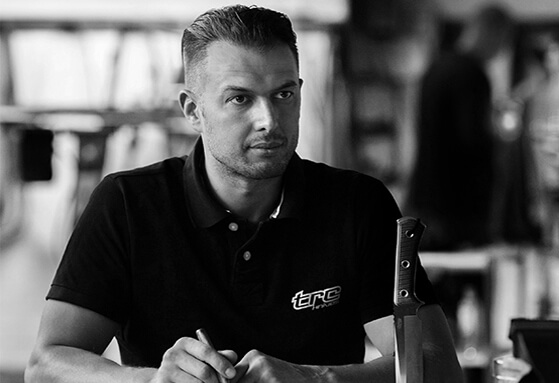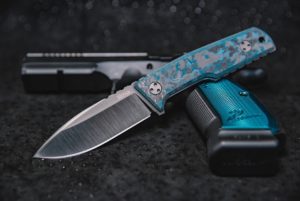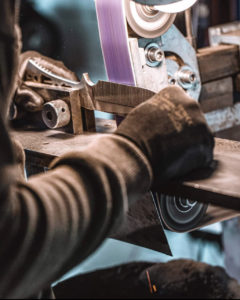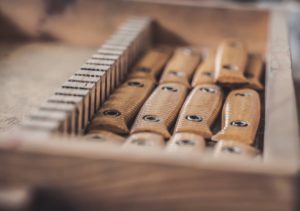What’s moving and shaking in the art of knife making?

Andrius Tricius, knifemaker, TRC Knives founder talks about knife industry trends, the key attributes of good knife, and history as the ultimate source of inspiration.
Let’s dive straight into the key trends that are shaping the knife industry. How should dealers and consumers choose between different producers, and different knife models?
The marketplace is very complex, but I will try to simplify it for you. The industry is divided into two main groups of knife manufacturers. One group of knife mak- ers are all about the utilitarian quality of their knives. How well and how long will a knife perform in heavy duty operations? That’s their main question, and their main objective. They use simple, but efficient and time-tested materials to make high-performing knives. For these manufacturers, design is merely an afterthought. The other group is all about design and the artistic value of the knife. What they are targeting are not users, but rather collectors of high-end knives. They operate under an assumption that, whoever agrees to pay a hefty price for a luxurious knife, will be reluctant to put that knife to use. Some of these knife makers describe their products as jewellery for men, which tells a lot about their approach.
And where do you stand in this divide?
We want to make this dichotomy obsolete. In my opinion, a perfect knife should be both useful and valuable as a collectable. So, let’s say a man is a bushcraft enthusiast, and he will use the knife every week on his expeditions. Now let’s say after twenty or so years he passes the knife on to his son. His son, let us suppose, is more of an indoor type guy, but he values the knife as a family relict and a collectable item, and he exhibits the knife behind glass in a display cabinet. But then, years later, his son picks it out of the cabinet, and takes his grandfather’s knife on a camping trip. And it works fine all these years later. At TRC Knives, we handcraft knives for such scenarios. Quality, utility, longevity and design must all go hand in hand. We are awake to the fact that even collectors are more appreciative of a knife that was actually made for cutting, not just for good looks. We real- ize this is a very ambitious paradigm. But that’s what we are striving for.
You identified quality, utility, and longevity as the key characteristics of a good knife. What factors go into making such a knife? And what mistakes in the manufacture process can produce a bad knife?
A bad knife has a blade which is either too hard, or too soft. You need a sweet spot which is very hard to achieve. A blade that is too hard will lack elasticity and will suffer damage when used in contact with hard materials. A blade that is too soft will lose sharpness and will wear down quickly. Knives need to be hard enough to hold a sharp edge through continuous use, yet flexible enough to withstand forceful use without break- ing.
And how do you find the sweet spot?
It takes years of experience to master the art of proper heat treatment. It takes knowledge of different heat-treating processes and the features of different types of steel. You also need to have delicate temperature controlling equipment. So, it’s a combination of having state-of-the-art machinery, scientific knowledge, and craftsmanship which can only be acquired through years of practice. You can read thou- sands of erudite tomes on metallurgy, and you will learn a lot. But in the end, experience is the best teacher.
Heat treatment consists of three main stages: hardening, cryogen- ic cooling and tempering. To achieve perfection, you have to follow this technological process with maximum precision. If done correctly, heat treatment gives you an edge that is hard enough to hold sharpness for long periods of time, and is resistant to wear. But you also have elastic properties: when it comes to contract with harder materials or encounters shock, the blade won’t chip or break. Just one single mistake in the heat treatment process, however, can compromise this balance. A cou- ple of minutes too long in the heat or a couple degrees of the mark and you end up with a badly treated blade. At TRC Knives, we take heat treatment very seriously.
And what about the materials the knives are made of?
We use the best materials in the market. Some of our favorite materials are powder metallurgy steels, mainly from Bohler-Uddeholm, such as M390, Elmax, Vanadis 4 Extra. When it comes to handles, TRC gives preference to three top quality materials:
Micarta ® – our most beloved handle material which is made from cotton canvas. It is strong, reliable and gives users that great natural feel when holding the knife.
G-10 – composite material made from glass fibers. It comes in a variety of vivid colours and is practically indestructible.
Carbon Fiber – extremely light and strong material that we use mainly in our custom knives. Due to its fancy looks and patterns, this material is greatly appreciated by professional knife collectors.
How are new models born at TRC knives?
I could talk hours about this. But I’ll try to make it short. To make constant improve- ments in functionality, ergonomics, and product longevity, you have to talk to the actual users of the knives. There- fore, we keep regular contact with the military, the hunter community, and regular knife enthusiasts, campers, bushcrafters, etc. After several
prototypes of a new model are
made, we distribute them among the experts. Corrections and improvements are then made according to the feedback we receive. What I also like to do is to hold the knife in my hand while I am sleeping. I know it sounds bizarre. But when I wake up, I know what changes need to be made to make the knife feel as a natural extension of the hand. In the end, only around one out of ten models we create is selected by our team of professionals to be offered to our dealers and end-customers.
Your answer covers functionality. But what about style and design? TRC collection features an impressively rich variety of different styles, sizes and designs. Where does this creativity come from?
For one thing, you have to analyse the market and the changing preferences of consumers. But you cannot simply react to market trends, because then you will be a copycat with zero originality and innovation. I think what drives us most at TRC Knives is our passion for history: both knife history, and general history. Most of our guys are big readers of historical literature. Many of our new ideas originate from these readings and the discussions we have about them in the workshop. As you can see, we have also reworked our branding along these lines. Our knives celebrate the stories of the great men that made history fascinating.
Interview given in mid-2019 on the occasion of the publication of the TRC Knives catalog dedicated to the new knife collection “Blades of Honor, Tales of Man”.
Źródło zdjęć: www.trcknives.com




